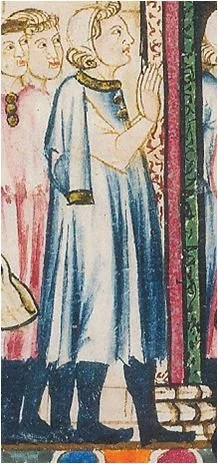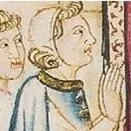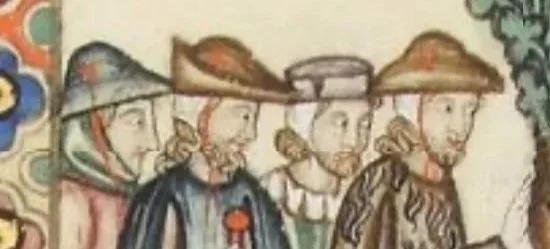13th century menswear: Christian Spain
undergarments: Camisa y bragas (shirt and braies)
White or natural linen shirt (camisa) and a pair of short or long white or natural linen braies (bragas) were the basis of most Christian men’s outfits. These would be paired with hosen in various colors, usually made of wool, linen, or silk. Sometimes men are shown barefoot or bare legged, which may be an indication of the activities in which they are involved rather than a common fashion element.
First layer: Sayo (gown)
Knee to calf length gown (sayo), usually long sleeved with a buttoned or keyhole neckline. Common fabrics were linen, wool, and silk. Hanging sleeves were common (Image 4).
Higher status men (usually younger) are often seen wearing an extremely tightly fitted sayo with lacing (encordata) that exposes the camisa on one side (Image 5 & 6). Sometimes the upper torso was decorated with strips of fabric as seen in Image 6.
second layer: pellote
Knee to calf length surcote (pellote) with extremely deep armholes. Could be made of wool, linen, or silk. Fashionable young men often wore pellotes that were extremely narrow through the top and much shorter, often with dagged or fringed hems.
Decorations often included armholes bound with fabric in gold or black and white checks (possibly an indicator of ermine?), woven or applied stripes (8, 9), or intricately woven patterns such as the heraldic burial garments of Fernando de la Cerda (7).
warmth layer: garnache
1. “Pilgrims” Cantigas de Santa Maria 2. “Pilgrims” Cantigas de Santa Maria 3. “Pilgrims” Cantigas de Santa Maria
The garnache is an outdoor/traveling garment shaped essentially like a sayo, but with a fuller body and larger, looser sleeves. Both hanging sleeves and long rectangular sleeves are seen.
headwear: cofias y tocas (coifs and hats)
Men’s hats are found in a wide variety of shapes, from a simple coif (cofia) to the very elaborately decorated capiello. In general, younger men left their hair loose or wore a cofia, while older men covered their heads. The basic cofia seems to be made of white or natural linen, and is often worn in combination with other hats (see Image 5). This probably serves to keep hair oils and other dirt from soiling the other hat.





























